
Kid Icarus is a platform video game developed and published by Nintendo for the Family Computer Disk System in Japan and the Nintendo Entertainment System in Europe and North America. It was released in Japan in December 1986, in Europe in February 1987, and in North America in July.

Dr. Mario is a 1990 puzzle video game developed and published by Nintendo for the Nintendo Entertainment System, Famicom, and Game Boy. It was produced by Gunpei Yokoi and designed by Takahiro Harada. The soundtrack was composed by Hirokazu Tanaka.
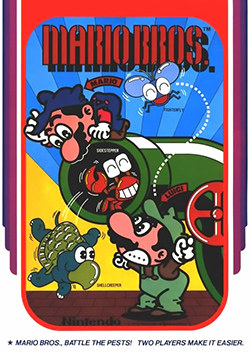
Mario Bros. is a platform game developed and published by Nintendo as an arcade video game in 1983. It was designed by Shigeru Miyamoto and Gunpei Yokoi, Nintendo's chief engineer. Italian twin brother plumbers Mario and Luigi exterminate creatures, like turtles (Koopas) and crabs emerging from the sewers by knocking them upside-down and kicking them away. The Famicom/Nintendo Entertainment System version is the first game produced by Intelligent Systems. It is part of the Mario franchise, but originally began as a spin-off from the Donkey Kong series.

Super Mario Bros. 3 is a platform game developed and published by Nintendo for the Nintendo Entertainment System (NES). It was released for home consoles in Japan on October 23, 1988, in North America on February 12, 1990 and in Europe on August 29, 1991. It was developed by Nintendo Entertainment Analysis and Development, led by Shigeru Miyamoto and Takashi Tezuka.
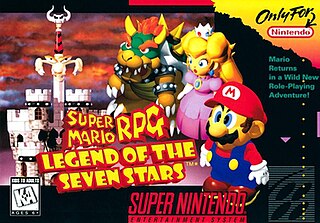
Super Mario RPG: Legend of the Seven Stars is a role-playing video game developed by Square and published by Nintendo for the Super Nintendo Entertainment System (SNES) in 1996. It was the final Mario game published for the SNES. The game was directed by Chihiro Fujioka and Yoshihiko Maekawa, produced by Shigeru Miyamoto, and scored by Yoko Shimomura.

Tetris Attack, also known as Panel de Pon in Japan, is a puzzle video game developed by Intelligent Systems and published by Nintendo for the Super Nintendo Entertainment System. A Game Boy version was released a year later. In the game, the player must arrange matching colored blocks in vertical or horizontal rows to clear them. The blocks steadily rise towards the top of the playfield, with new blocks being added at the bottom. Several gameplay modes are present, including a time attack and multiplayer mode.
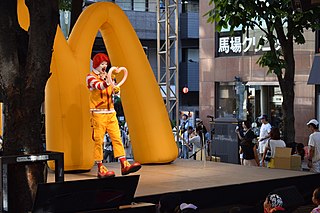
McDonaldland is a McDonald's media franchise and the fictional fantasy world inhabited by Ronald McDonald and his friends. Starting with the creation of Ronald McDonald in 1963, it is primarily developed and published by McDonald's. Initial attempts to expand the McDonaldland universe by marketing agency Needham, Harper & Steers were seemingly retconned due to legal issues, but ongoing aspects were expanded in McDonald's projects in collaboration with Data East, Virgin Interactive, Treasure, SEGA, and Klasky Csupo.

The Nintendo VS. System is an arcade system developed and produced by Nintendo from 1984 to 1990. It is based on most of the same hardware as the Family Computer (Famicom), later released as the Nintendo Entertainment System (NES). Most of its games are conversions from the Famicom and NES, some heavily altered for the arcade format, and some debuted on the VS. System before being released on the Famicom or NES. The system focuses on two-player cooperative play. It was released in three different configurations: upright VS. UniSystem cabinets, upright VS. DualSystem cabinets, and sit-down VS. DualSystem cabinets. Games are on pluggable circuit boards, allowing for each side to have a different game.
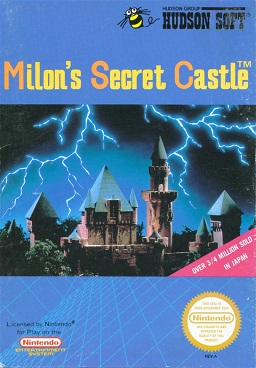
Milon's Secret Castle, known in Japan as Meikyū Kumikyoku: Milon no Daibōken, is a 1986 action-adventure game released by Hudson Soft for the NES. A Game Boy version was released in 1993. A sequel, DoReMi Fantasy, was released in 1996 for the Super Famicom.

Global Gladiators is a 1992 platform game developed by Virgin Games USA, originally programmed by David Perry for the Sega Genesis and eventually ported by other Virgin Games teams in Europe to the Master System, Game Gear, and Amiga. The game is based on the McDonald's fast food chain and has a strong environmentalist message.

Donald Land (ドナルドランド) is a 1988 platform video game produced by Data East in association with the McDonald's Corporation for the Family Computer, based on the McDonaldland franchise.

McDonald's Treasure Land Adventure is a 1993 platform game developed by Treasure and published by Sega for the Sega Genesis. Based on the McDonald's fast food restaurant chain, specifically its McDonaldland marketing campaign, players control Ronald McDonald in his efforts to retrieve the missing pieces of a map that lead to the location of a buried treasure from a group of villains. Ronald can defeat enemies by using a magic attack and can latch onto hooks with his scarf to reach higher platforms.
Ronald McDonald is a clown character used as the primary mascot of the McDonald's fast-food restaurant chain. He inhabits the fictional world of McDonaldland, with his friends Mayor McCheese, the Hamburglar, Grimace, Birdie the Early Bird and The Fry Kids.

The Wacky Adventures of Ronald McDonald is an American animated mini-series of retail direct-to-video episodes produced by Klasky Csupo in association with the McDonald's Corporation, centering on the zany hijinks of McDonald's mascot Ronald McDonald and the gang in McDonaldland. A total of six 40-minute episodes were produced and released on VHS with five of them being available exclusively in participating McDonald's restaurants from October 9, 1998 to January 30, 2003.

Mario, or Super Mario, is a Japanese multimedia franchise created by Japanese game designer Shigeru Miyamoto for video game company Nintendo which produces and publishes its installments. Starring the titular Italian plumber Mario, it is primarily a video game franchise, but has extended to other forms of media, including television series, comic books, a 1993 feature film, a 2023 animated film and theme park attractions. The series' first installment was 1983's Mario Bros., although Mario had made his first appearance in 1981's arcade game Donkey Kong, and had already been featured in several games of the Donkey Kong and Game & Watch series. The Mario games have been developed by a wide variety of developers including Nintendo, Hudson Soft, and AlphaDream. Mario games have been released almost exclusively for Nintendo's various video game consoles and handhelds, from the third generation onward.

Super Mario All-Stars is a 1993 compilation of platform games for the Super Nintendo Entertainment System (SNES). It contains remakes of Nintendo's four Super Mario games released for the Nintendo Entertainment System (NES) and the Famicom Disk System: Super Mario Bros. (1985), Super Mario Bros.: The Lost Levels (1986), Super Mario Bros. 2 (1988), and Super Mario Bros. 3 (1988). As in the original games, players control the Italian plumber Mario and his brother Luigi through themed worlds, collecting power-ups, avoiding obstacles, and finding secrets. The remakes feature updated graphics—including the addition of parallax scrolling—and music, modified game physics, a save feature, and bug fixes.

The Game & Watch brand is a series of handheld electronic games developed, manufactured, released, and marketed by Nintendo from 1980 to 1991. Created by game designer Gunpei Yokoi, the product derived its name from it featuring a single game as well as a clock on an LCD screen. The models from 1981 onwards featured an alarm in addition.
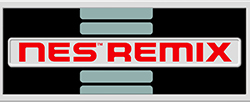
NES Remix is a compilation video game series for Wii U, developed by Nintendo. The first and eponymous game was simultaneously announced and released on December 18, 2013, on the Nintendo eShop following a Nintendo Direct presentation. A second game, NES Remix 2, was released on April 25, 2014. A retail edition consisting of both games, titled NES Remix Pack, was released on April 24, 2014, in Japan and December 5 in North America. Another title, Ultimate NES Remix for Nintendo 3DS, was released on November 7-8, 2014 in Europe and Australia, December 5 in North America and August 27, 2015, in Japan.

Mario vs. Donkey Kong is a crossover spin-off video game series of both the Mario and Donkey Kong franchises, based on puzzle platforming, marking the return of Pauline and the rivalry between Mario and Donkey Kong.




















